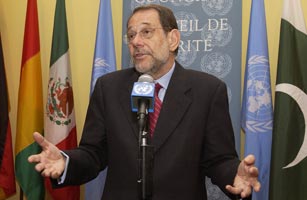
European Union foreign policy chief Javier Solana responds to a question at the United Nations in New York on May 6, 2003.
Over the past two and a half years of intifadeh, more than 3,000 Israelis and Palestinians have been killed. Many were civilians, including the young people slain by a suicide bomber Wednesday while enjoying themselves in a Tel Aviv bar and those that died when tanks rolled into Gaza a few days later. How do we put an end to terrorism and violence? How do we put an end to occupation and normalize the lives of Palestinians and Israelis? Hearts and minds have to be turned against violence. That is exactly the meaning of the road map — a map for a Middle East in peace, a road that leads to it.
The U.S., the E.U., the U.N. and Russia — the "quartet" — officially presented the road map to both parties last week. This is a strong coalition for peace that started work a year ago. Our objective is to move from retaliation to confidence, from hatred to dialogue, from conflict to peace. Our aim has been to recreate a path to negotiation and a road toward peace. It has taken time to identify the necessary parameters. This has been done taking careful account of the aspirations and fears of both Israelis and Palestinians.
There have been divisions within the international community on important issues in recent months. The quartet is not a symbol, but a concrete manifestation of a common international desire to promote the peace that Israelis, Palestinians and all the people of the region deserve. Some have objected that we have wasted time, or that we came too late. This is not the point. The point is that, together, we have found enough will to try to bring about some success. The point is that Palestinians and Israelis are ready themselves to embark upon this road. They have questions, even reservations. But they also feel that this is an honest view of what can be achieved and how it can be achieved. They are also aware that a continuation of the current crisis will only deepen the already complex issues that a renewed peace process will have to address.
From now on, not a day should be lost. The road map contains a very demanding agenda for a final settlement by 2005, when Palestine and Israel can live side by side in peace, within secure borders. Some key elements in the road map are already in place, such as the nomination of a new Palestinian cabinet. But a lot remains to be done on both sides.
I have dedicated a large part of my efforts to overcome the crisis that began in 2000. From the October 2000 Sharm-el-Sheikh summit up to the Mitchell Report — in the drafting of which I had the honor to participate under the chairmanship of Senator George Mitchell — agreed-upon proposals have failed to be implemented. Most of them are still largely relevant and are incorporated in the road map. There is one main reason for this lack of progress: we had a clear view of the objective but were unable to make the first step.
Europe is deeply concerned by the crisis. It touches our Mediterranean neighborhood. For years, we have been advocating a two-state solution, the end of occupation, but also the recognition of Israel by all its neighbors. The parties will need all the friendship, support and encouragement we can give them to attain these objectives. This is truer than ever after more than 2 1/2 years of bloody confrontation, which has touched personally nearly everyone in the area. The peace camp in Israel has had its certitudes shaken and has largely fallen silent. The peace camp among Palestinians faces the double challenge of a despairing population under severe military occupation and of extremists using terror in order to sabotage all attempts to renew dialogue.
We are realistic. There will be no peace without the U.S. However, the U.S. and the E.U. together have an even better chance of success. But the U.S. and Europe will have to buckle down and take hard decisions in the coming weeks and months if peace is to prevail. Peace treaties signed between Israel, Egypt and Jordan were possible because of courageous leaders supported by Washington. Today, Europe, America, the U.N. and Russia can help if they act together. The renewed commitment on the part of the U.S. to that end should reassure all the parties. Last week, President Bush reaffirmed his engagement and we have, as Europeans, welcomed it, just as I welcomed his vision of two states living side by side by 2005, which he expressed on June 24 of last year.
We are realistic, but we also want to bring hope. Without a search for a comprehensive and lasting peace, the vision of the future will be blurred for a whole generation of Israelis, Palestinians and their Arab neighbors. The road map could be instrumental in bringing Syria and Lebanon back to the peace process. In addition, both countries should be full partners of the coalition for peace. Leaders in the region now have a key responsibility to assume leadership. In their difficult task, they will enjoy our support — on a daily basis, starting now.
Javier Solana is the European Union's High Representative for common foreign and security policy